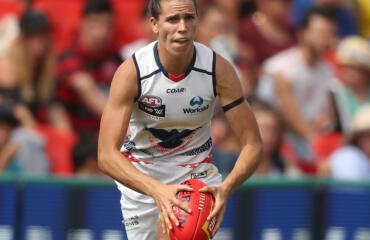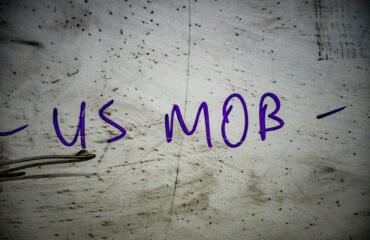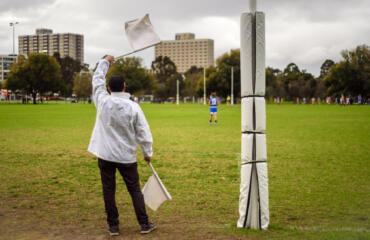
Crème de la crème: the top 10 picks in last year’s national player draft. PIC: AFL Media
“So, what do you do on a daily basis to avoid sexual assault?” a former professional Aussie Rules player, now educational presenter, recently asked a group of young, elite footballers, some barely 18 years-old.
Luke Brennan waited patiently for an answer as a nervous giggle rippled through the room.
“Nothing,” one player finally admitted.
Brennan, 30, who played 28 games for Hawthorn and Sydney a decade ago, responded calmly.
“Ok, now I want you to go home and ask your sister, or your mother, or your girlfriend, or your wife, or any other important woman in your life, what they do on a daily basis to avoid sexual assault. See what they say.”
Welcome to the Australian Football League’s frontline effort to shape the minds – and lives – of those chosen to play the most popular sport in Australia at the highest levels.

When these young men had their names called out at the league’s annual player lottery, the national draft, it signalled the beginning of a career that averages about six years; signalled the beginning of gruelling physical demands, ice baths and painful injuries, of contract negotiations and agents and more money than most of them could ever have imagined, and of social media accounts with thousands of followers and a public profile that would usurp their anonymity.
It signalled, too, their adherence to strict nutritional plans, drug tests, curfews and a ban on drinking alcohol for seven months of the year.
And, since the AFL introduced its respect and responsibility policy in 2005, it has also signalled new learning about what it means to behave well – not just about how to be a model footballer, but a model citizen as well.
“We were wondering about where we could get some traction in promoting the concept of prevention – that is, stopping sexual assault from occurring in the first place,” the inaugural manager of the policy, sociologist Melanie Heenan, told The Citizen.
“We knew that footy and sport could be a really solid vehicle for starting that conversation.
“Certainly, the AFL was seen back in the early 2000s as not having addressed or even identified that there were problems with the way that women, or gender, were understood or responded to.”
The catalyst for change came in March 2004 when two St Kilda players were investigated for alleged sexual assault, a controversy that would play out over the next decade.
The incident prompted then-AFL boss Andrew Demetriou to invite the victims of sexual assault at the hands of AFL footballers to come forward. Many did.
“Ok, now I want you to go home and ask your sister, or your mother, or your girlfriend, or your wife, or any other important woman in your life, what they do on a daily basis to avoid sexual assault. See what they say.” — the AFL’s Luke Brennan, to a group of young footballers
Dr Heenan, who was then working for the Australian Centre for the Study of Sexual Assault (ACSSA), took a keen interest in the media spectacle.
“In the first instance, the AFL weren’t really sure if this was a case of a couple of bad apples – if it was just one incident – or whether they needed to look at a deeper, cultural problem. Andrew started to have a broader conversation with the community about what the AFL and clubs needed to do differently in this space.”
Suddenly, what appeared to be a fundamental problem across the football code became a focus of attention, culminating in the league’s respectful relationships policy.
“The discourse around prevention [of violence against women] was really under-developed at that time. It was really new to Victoria and to Australia,” Dr Heenan explained. “There was a lot of interest in seeing if this was an opportunity to work with the AFL on thinking about themselves as a workplace and a culture that could change.”
Ten years on, the respect and responsibility policy and its associated educational program – designed to teach footballers about respectful relationships – is still presented and taught annually to players and staff at all 18 AFL clubs. And its messages percolate beyond the elite to suburban and country leagues where part-timers and amateur players are presented with the same program.
Mr Brennan, who with fellow educational project officer Rebecca Mathers is charged with delivering the R&R program to footballers across the country, has been a strong advocate in the community, too.
“When we talk about the prevention of violence against women, in many people’s minds the AFL is probably not something that’s synonymous with the topic,” he told a VicHealth domestic violence conference recently.
“But we have done a lot of work in this space over the last 10 years. We have committed a lot of money and resources to it, and will continue to do so.”
With more than 32,000 people on average attending each AFL game in 2015, and a TV audience of many millions, Mr Brennan argues that the popularity of the sport makes the AFL a powerful vehicle for social change.
“Our ability to raise awareness of key social issues is really strong, especially given the strength of our brand in some of the key demographics we are looking to target – 18-to-35 year-old males,” he said.
“Obviously the AFL logo becomes really handy in being able to access areas that we wouldn’t normally be able to access when we talk about the prevention of violence against women.”
Likewise, Vanessa Born, the media projects manager for Domestic Violence Victoria, acknowledges the power of the sporting hero in influencing community behaviour.
“Violence against women and its prevention requires institutional, organisational and community responses,” she said. “Sporting communities and cultures are a part of that and they have incredible access to young men to talk to them about violence against women, and gender inequality as one of its main causes.
“The community as a whole often look to sporting players for general community behaviour, and what’s ok and what’s not.”
While the league’s respect and responsibility program has been in place for a decade, details of how it works and how the policy is evaluated has received only scant media attention. But Mr Brennan’s presentation to the VicHealth conference shed light on specifics.
The R&R effort, at a player level, is split into two parts: it’s an AFL rule by which players must abide or face consequences, but also an education program reaching beyond the elite and into suburban and country leagues throughout Australia.
Mr Brennan said the R&R sanctions were an important part of keeping elite players accountable.
“Looking at building respect and responsibility messages into the AFL player rules was a key component [of the policy],” he said. “If a player, for example, commits a violent act towards a woman, then that actually has a consequence on-field. It’s built into the player rules, and therefore built into their contracts.”
But Mr Brennan said player and staff education remained the policy’s primary focus.
“It’s about bridging the gap between gender equality and prevention of violence against women. Getting them to see that once we change mentality, we can get the attitudes and behaviours of men to change too,” he added.
Since 2009, Mr Brennan and Ms Mathers have travelled to each of the 18 AFL clubs at the outset of the season or in September, which is seen as a ‘high risk’ period when players go on their annual break.
“Violence against women and its prevention requires institutional, organisational and community responses. Sporting communities and cultures are a part of that and they have incredible access to young men to talk to them about violence against women, and gender inequality as one of its main causes.” — Vanessa Born, Domestic Violence Victoria
Additionally, program facilitators in each state will drive up to four hours at a time to deliver the program to community clubs.
The program is workshopped for about 90 minutes at a time, in interactive sessions, sometimes involving more than 100 players and staff. The sessions are often combined with programs on related social issues, including drug and alcohol abuse.
The question that Mr Brennan typically poses to the young players of an AFL club – “What do you do on a daily basis to avoid sexual assault?” – is used to unpack some of the underlying causes of violence against women, including gender inequality.
His program partner, Ms Mathers, said that players often did not consider what women did daily to keep themselves safe, and were invited to consider how that compared to a man’s life.
“We had one interstate player – so, [someone] who travels a lot – who went home and asked his wife that question. He was really shocked by her response,” Ms Mathers recalled.
“She said she slept with a knife next to her bed. She would sleep with the dog inside; she would make sure the windows were locked. It was something that he had never really considered: that when he went away for football, she was actually concerned for her safety.”
For many of today’s elite players, it is a message they have been receiving frequently since junior days. In fact, players are targeted as early as 15 through the AFL’s talent pathways – meaning, that by the time they make the grade, players could have been exposed to the respect and responsibility program four or five times. This can make variety in how the material is presented, such as personalising statistics, critical to its impact.
“One of the most powerful things I think – especially in the early days – was personalising it; saying ‘Ok, one-in-three women will experience some form of violence in their life. Who are three women in your life that you love and respect?’ ” Mr Brennan explained.
“All of a sudden, once you put domestic violence in the context of the women that they love, it has a much stronger, more powerful effect.”
Ms Mathers said victim interviews were also a key to changing false notions of what a victim of domestic violence looked like, and getting players to consider how widespread domestic violence was in Australia.
The AFL invited a domestic violence survivor to speak to a playing group about what she had suffered.
“She was a well educated young woman. She lived in a nice area of Melbourne. Her husband was a respected professional. All these things that a lot of people in the room probably thought didn’t fit the family violence stereotype,” Ms Mathers continued.
Other scenarios are focused more squarely on players’ every-day lives, including social media use and the distribution of risqué images sent to them by sexual partners or girlfriends.
“In this day and age, it’s one of the biggest issues we have. With smart phones and iPads and social media. I think inherently they know it’s wrong, but sometimes a need to be accepted into the group over-rides it,” Mr Brennan said.
Incorporated into the educational program, too, are a series of short videos created by one of the AFL’s media producers, Shaun Vance, which draw on examples of senior AFL players using social media constructively, and also those whose careers had suffered through misuse.
Mr Vance, who was present at the Richmond Football Club when the videos were shown earlier this year, said he felt confident the message was getting through.
“[The players] are pretty open to it. It’s really their time, so they can be as open as they want to be,” Mr Vance said. “You can see their eyes widen. All of a sudden these young boys are responsible for more than themselves.”
Added Mr Brennan: “We are trying to get through to them that they are not invincible, they are not anonymous.”

One difficulty with the AFL’s R&R education program is in its evaluation. How is it possible to see that the player’s behaviour and attitudes have been changed?
But Melanie Heenan believes the policy’s “power” can be a little lost when it is narrowed to an educational program alone because “the policy speaks to something much bigger than that”.
“I think people’s comfort level was ultimately that the programs should be directed at the players. They are the ones that are the greatest risk for clubs, obviously, but also for women and potential victims. But for me, it was actually about a culture of respect across the football community.”
Ms Mathers and Mr Brennan agreed that it was difficult to make a definitive claim about the results of the program. Instead, the AFL concentrated on improving the presentation of the education, with player and staff feedback sought after every session.
Ms Mathers said that while players found it relatively easy to relate to speakers such as the young domestic violence survivor, sessions involving police had been less successful. Even so, victim testimony also raised issues, with some players defensive when shown a clip from SBS’s Insight program about a woman that had been sexually assaulted by a group of rugby players.
“It’s really hard for us to present something like that without them thinking we are accusing them or that we think they are going to go and do the same thing,” Ms Mathers said.
“So it was really important to keep it very casual and very open so that they could ask questions. It was getting them to see what it looks like from the victim’s point of view, but then how that group mentality works when it comes to sexual assault.”
Mr Brennan added that the “by-stander theory” was integral to the players seeing the education as something they may have to put into practice in a group situation.
“We want to empower players and men to think they have a role in the prevention of violence against women. I think too often in this space, we rarely look at the man and their own behaviours.”
Despite these teaching issues, Mr Brennan said he could see significant changes in the attitudes of AFL players.
“This wasn’t just about sending out some education modules. My eye was always tilted a little towards the horizon. For me, the benefits of the policy and why I went into the role, was because it had a much broader remit about culture change in the offices of clubs.” — inaugural R&R policy manager Melanie Heenan
“You can see it just in their language – when you see a guy you spoke to at 15 or 16, and then speaking to the same player five years later about violence against women. They get the information,” Mr Brennan said.
“Whether that transcends into behavioural changes is a different story. But I think they are one of the more educated groups of guys in this space.”
Despite the apparent success of player and staff educational programs, the AFL has come under fire mid-year from Richmond president Peggy O’Neal for not doing enough to increase the involvement of women within the AFL.
“Respect and responsibility didn’t necessarily translate to women’s involvement in the business of the game,” she told The Age in July.
Former policy manager Dr Heenan agrees.
“This wasn’t just about sending out some education modules,” she said. “My eye was always tilted a little towards the horizon. For me, the benefits of the policy and why I went into the role was because it had a much broader remit about culture change in the offices of clubs.
“People don’t often think about footy clubs as much more then player groups and coaches and footy managers. But to think of them as a workplace, to see the back-end staff – the marketing staff, events staff, admin staff – that was of great interest to me. How the policy could drive change across those dimensions of football as an industry.”
Dr Heenan said that a lack of female employment at clubs was an issue in 2005 and still needed attention in 2015 – “from middle management and up, it’s mostly men,” she said.
“I think there is still a real opportunity for the AFL to be on the front foot with the messaging around respect and responsibility in this regard.”
While work remained, Dr Heenan sees potential in the way AFL players have engaged with the issue of violence against women and advocated for change.
“Whenever I see them do that I feel very proud of them collectively. It could be bigger, we want it to be bigger, but it is there. They are prepared to challenge the worst incidents of discrimination that we see, including gender discrimination,” Dr Heenan said.
“This vehicle is as strong as any we’ve got in this country. And if it was used for good, in relation to gender and sex discrimination, then I think we can go a lot further. I think it’s capable of doing it.”
► If you or someone you know is impacted by sexual assault, domestic or family violence, call 1800RESPECT on 1800 737 732 or visit 1800RESPECT.org.au. In an emergency, call 000. For practical information and confidential support visit I-DECIDE, an online interactive tool for women in unhealthy or unsafe relationships.



